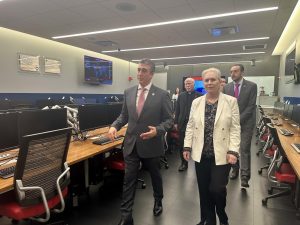Lifelike robots, time-warping display screens, skintight spacesuits, and even bionic dolphins descended on the Jacob Javits Center this weekend, showing off the technology of either tomorrow or never. While billed as the showcase of future technology, the Wired NextFest, held from Sept. 29 to Oct. 1, at times showed the results of over-imaginative MIT students.
Cool but impractical technology littered the show floor and drew big crowds, but the products that can actually have an affect in our lives really forecast a future filled with convenience and luxury.
The show was segmented into 11 pavilions highlighting the future of sustainable living, design, exploration, transportation, robotics, entertainment, play, health, communication, security, and imagination.
Architect Michael McDonough’s Arc-House was the center of sustainable living, tilting his buildings along the arc of the sun in order to efficiently use solar panels and expand room for large windows without compromising energy reserves, unlike many current solar homes.
Aggravated women scouring through the unlit caverns of their handbags may find Brunel University undergraduate Rosanna Kilfedder’s Sunstrap Handbag an ingenious solution, featuring illuminated lining in order to find keys, makeup, and gum easier in those hard-to-see spots.
The not-so-ingenious Hug-Shirt, however, by CuteCircuit, is an abomination of fashion and practicality.
By squeezing the sensors of the Bluetooth-enabled shirts, the Hug-Shirt works in collaboration with Bluetooth cell phones to send pressure sensitive vibrations to specified recipients, as long as they happen to be donning the same getup.
Unlike this month’s DigitalLife convention which takes place from Oct. 12 to Oct. 15 at the Javits Center, NextFest is more of a technical and professional convention than a consumer event, as the majority of exhibits featured technology that would affect the future of space and deep-sea exploration, health, and combat.
MIT’s Bio-Suit, which resembles a biker outfit, hopes to do away with what they call the “gas bag” look of current spacesuits, with layers of ultrathin materials that can protect humans in unearthly conditions and withstand extreme temperatures, pressure changes and radiation.
“We’ve already been to Mars and soon we will roam the moons of Jupiter, but meanwhile here at home roughly 95 percent of our oceans remain unexplored,” said Phil Nuytten of Nuytco Research. “This planet shouldn’t have been called ‘Earth,’ it should’ve been called ‘Ocean.'”
With that thought process in mind, Nuytco is working on Deep Worker, a one-man submersible that can plunge 2,000 feet underwater and carry life support to stay submerged for up to 80 hours.
The Deep Worker will allow researchers to gather samples from the seafloor that have currently been unexplored.
Nuytten and many others hope Deep Worker can change the future of deep sea exploration and allow scientists to learn more about life on this planet.
According to Westergaard Frandsen, inventor of the Lifestraw, more than 6,000 lives per year are taken by waterborne illnesses like Typhoid fever.
The Lifestraw, which will sell for only a few bucks, kills 99 percent of bacteria in drinking water, a possible solution for the millions of people in under-developed countries drinking unfiltered water.
Exhibits, NextFest was somewhat boring, but the technology it housed was undoubtedly important for the future of human life, entertainment, and survival.

















